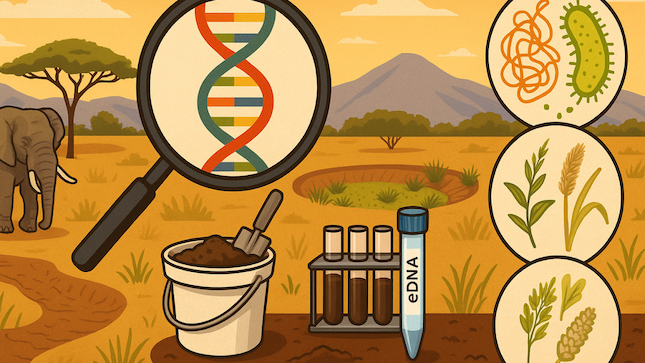In Kenya’s vast and fragile drylands, a new kind of science is helping restoration efforts take root. Across the arid rangelands of Laikipia County, researchers have turned to environmental DNA (eDNA) to track the early stages of ecological recovery, offering a glimpse beneath the surface into the unseen biodiversity that shapes soil health, vegetation, and livelihoods.
The Lower Naibunga Community Conservancy, located in one of Kenya’s most degraded arid and semi-arid landscapes (ASALs), is now the site of the country’s first comprehensive application of eDNA metabarcoding for restoration monitoring. By reading the genetic traces left behind in soil, the study reveals how restoration efforts—particularly water bunds and reseeding—are quietly transforming degraded land.
Why Monitoring Matters in Dryland Restoration
Kenya’s ASALs cover more than 80% of the country’s land area and support around 10 million people and 90% of the nation’s wildlife. Yet decades of overgrazing, tree loss, and worsening drought have left many areas deeply degraded. Restoration is a national priority, with Kenya committing to ambitious goals under frameworks such as the UN Decade on Ecosystem Restoration and the Bonn Challenge.
However, monitoring success has long posed a challenge. Traditional field surveys require time, taxonomic expertise, and resources that are often scarce, especially in remote, resource-limited settings. Worse still, such methods often miss below-ground biodiversity, which plays a crucial role in restoring ecosystem function.
This is where eDNA metabarcoding offers a powerful alternative. By analysing DNA fragments shed by organisms into their environment—through skin, roots, excreta, or decaying material—researchers can detect a broad range of species from a small sample of soil or water. It is rapid, non-invasive, and cost-effective at scale.
Restoring the Land: The Role of Water Bunds
The Laikipia study focused on semicircular water bunds, simple earthworks designed to trap rainfall and reduce erosion. Between February and March 2023, around 5,000 bunds were constructed across six sites with support from the Wyss Academy for Nature and active participation from local communities.
These structures slow water runoff, allowing it to soak into the soil. This creates small zones of improved moisture where vegetation can grow, helping to kick-start natural processes. To accelerate this recovery, the restoration team planted two drought-adapted grasses: buffel grass (Cenchrus ciliaris) and Maasai lovegrass (Eragrostis superba). Both are native to East Africa and known for stabilising soil, improving forage quality, and tolerating arid conditions.
The question the researchers set out to answer was simple: Are these interventions working?
How eDNA Metabarcoding Works
To find out, 18 soil samples were collected from georeferenced water bunds across the six study sites. Care was taken to prevent contamination, and the samples were kept cold and transported to the laboratory for analysis.
The team analysed two genetic markers:
- 16S rDNA, which identifies bacteria and archaea in the soil.
- rbcL, a chloroplast gene used to detect and classify plant species.
The sequencing process enabled researchers to match these markers to known species or genera in reference databases, providing a snapshot of the organisms living in or passing through each site.
What the DNA Revealed
Soil Microbes
The bacterial analysis identified over 19,000 unique DNA sequences, representing 40 microbial phyla and 554 genera. Among them were plant growth-promoting rhizobacteria (PGPR)—beneficial soil microbes that enhance plant nutrient uptake, help suppress disease, and support drought tolerance. These included:
- Bacillus circulans and Bacillus koreensis, known for nutrient solubilisation and stress tolerance.
- Bradyrhizobium elkanii and B. yuanmingense, nitrogen-fixing bacteria that help convert atmospheric nitrogen into forms that plants can absorb.
Also detected was Arthrobacter alpinus, a bacterium that breaks down organic sulphur compounds, suggesting early signs of natural soil remediation and ecosystem function.
Vegetation
The plant DNA data revealed 814 unique sequences across 36 genera. Buffel grass (Cenchrus ciliaris) was the most abundant species across all sites, indicating strong establishment success. However, Eragrostis superba, though known to be present, was not detected—most likely due to gaps in the global DNA reference databases rather than its absence on the ground.
The analysis also revealed several native or naturalised plants with ecological or cultural importance:
- Zaleya pentandra, a hardy ground cover that helps stabilise soil.
- Leonotis leonurus (wild dagga), valued for its medicinal properties and pollinator support.
- Food-producing legumes such as Arachis duranensis (wild peanut) and Cicer arietinum (chickpea).
However, the study also flagged emerging threats. DNA from invasive or toxic species was present, including Heliotropium europaeum (European heliotrope), which is poisonous to livestock, and Eriochloa villosa, a highly competitive grass that can displace native species.
Restoration in Action: What the Results Show
This study demonstrates that even within a year, restoration interventions—when supported by water retention structures and seeding—can begin to regenerate biodiversity in degraded drylands.
The detection of microbial communities known to promote soil health and support plant growth points to promising early recovery. The successful establishment of planted grasses, such as buffel grass, alongside the reappearance of ecologically valuable native species, suggests that bunds are not only holding water but also laying the foundations for broader ecological regeneration.
The discovery of forage species, medicinal plants, and nitrogen-fixers also highlights how restoration can strengthen local livelihoods, supporting grazing, food resilience, and traditional knowledge systems.
At the same time, the presence of invasive or harmful plants reminds us that restoration must be actively managed. The ability of eDNA to pick up such species early on adds to its value as a risk detection tool.
Limitations and Future Directions
The study also highlights areas for improvement. Gaps in global DNA reference databases, particularly for African plants, limit taxonomic precision. The absence of E. superba from the dataset is likely due to such limitations. Expanding these databases will be key to improving the accuracy of future monitoring.
In addition, while eDNA can tell us what species are present, it cannot measure structural features such as plant height, canopy cover, or reproductive success. Nor does it directly assess animal presence or behaviour. For these reasons, the researchers recommend combining eDNA with conventional monitoring methods—such as field surveys, photographic plots, and remote sensing—to build a more complete picture over time.
A Model for Scalable, Science-Based Restoration
What makes this study especially valuable is its demonstration of what is possible when local knowledge is combined with modern molecular science. The water bunds were built by communities using locally understood techniques. The biodiversity data were generated using frontier tools. Together, they provide a model that is practical, affordable, and scalable across similar landscapes.
As Kenya and many other countries work towards large-scale restoration goals, especially under the UN Decade on Ecosystem Restoration, this kind of monitoring will be essential. Without credible, high-resolution data, it is not easy to assess impact, attract investment, or adapt restoration strategies to changing conditions.
This research demonstrates that eDNA metabarcoding provides a viable and effective means to bridge that gap, offering new transparency in how we measure recovery and new accountability in how we manage it.
In these landscapes where life has been stripped back to its basics, recovery is possible. And with the right tools, we can now see it happening—not just above the ground, but deep within the soil.



